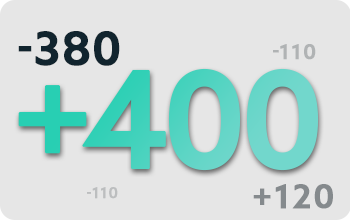Betting Odds

Gambling exists in a land of odds. But odds come up all the time in everyday assessments. So, if you know how betting odds work in the gambling world, you will know what they mean when applied to other things such as science, entertainment, and politics.
Read along, and learn more about the different types and what they mean. This guide will help you learn the value of betting odds to optimize your chances of winning and better understand gambling risks.
Betting Odds Guide
Everything You Need to Know
What Are Betting Odds?
Odds represent the chance of an event occurring. There are different types of bettings odds, but they are all based on probabilities and indicate the number of potential winnings.
Knowing odds is essential in any form of gambling. For instance, if you approach a blackjack table, you want to know what “Blackjack pays 3:2” means. In the case of sportsbooks, you need to know what “-210” means next to a team or what “5-2” means on a horse.
How Do Betting Odds Work?

Casinos set odds for all events and games with the casino’s profits in mind. For instance, with sporting events, the casinos will establish the odds on an event based on how they think the betting public will wager.
They want one-half of the public to bet on one side and one-half to favor the other side. Sites profit from the differences in the odds on each side, or the “juice,” the percentage they charge bettors.
Casino games work a little differently. The rules of blackjack, roulette, and other casino games are gauged for built-in profit. While the deals, spins, or rolls are random, the rules dictate outcomes that favor the casino. It is known as the “house edge.” You want to reduce the house edge as much as possible, which is a big reason why you should understand how betting odds work.
Types of Betting Odds
Betting odds come in three basic forms –fractional, decimal, and money line. It is the same concept expressed in different terms, and you can convert one to another. For example, 3-1 (fractional) is the same as 4.0 (decimal) or +300 (money line). There is no difference in the payouts. Let’s take a closer look at each one.
Fractional Odds | British

Fractional odds are the most common and are used the most by bookies in the United Kingdom. These represent the ratio of the amount you win according to your wager amount. You will usually see them posted with a hyphen (2-1) or slash (2/1). Casinos like to use a colon (2:1) to post fractional odds with their games.
They are spoken as “two to one.” Two to one means winning $2 for each $1 you bet. So, if you bet $10, you would collect $20 of profit, plus of course, the $10 you wagered. The same goes for 3:1. You get a $3 profit for each $1 you bet.
But what about 3:2, the odds for a blackjack? That’s $3 for each $2 you bet. Or, to reduce the fraction, $1.50 for each $1.
Decimal Odds | European

Decimal odds, also called digital or continental, are used mainly in Europe, Canada, Australia, and New Zealand. They are the easiest to understand because they represent your total payout for each $1 you bet, not just your profit.
So, if the decimal odds are 1.3, you are paid $1.30 for your $1 bet, $13 for your $10 wager, or $130 for $100 wagered. At 5.1, you are paid $5.10 for your $1 stake or $51 for a $10 bet. It’s just a matter of moving the decimal, and it equals your bet plus your profit.
Money Line Odds | American

Money Line odds work on a plus (+) and minus (-) basis and indicate the amount you need to wager to win $100.
So, if you bet $10 on a play at +550, you win $55.
If you bet that same $10 on something at -150, you win $6.67 for a total payout of $16.67. That’s the win plus your wager. You see money line odds primarily with sports events and mainly in the US.
Using Betting Odds to Calculate Probability
Of course, odds in gambling are implied probabilities because you can’t predict an outcome. But you can calculate these probabilities using odds, which will give you a good perspective on your chances of winning. And with gambling, the lower the chances of winning, the higher the return.
Let’s use our formulas to reveal the probability of outcomes.
Probability with Fractional Odds
If you face 5:1 fractional odds, here is how you figure your chances.
- 5 + 1 = 6 or 1 divided by 6 is 0.167 that equates to a 16.7% probability.
- 5:2 odds figure the same way. 5 + 2 = 7 or 2÷7 = 0.285 or a 28.5% chance.
- If you take a favorite at 2:5, it’s 2 + 5 = 7 and 5 ÷ 7 = 0.714, or 71.4%.
Probability with Decimal Odds
Calculating probability with decimal odds is simpler. Here you divide 1 by the number.
- With 5.0 odds, divide 1 by 5 and get 0.20 or 20%
- 8.0 odds is 1 ÷ 8 = 0.125 or 12.5%.
- 1.40 odds is 1 ÷ 1.4 = 0.714 or a 71.4% chance.
Probability with Moneyline Odds
You can convert moneyline odds to fractions and use the fractional formula to determine a probability.
- +500 is the same as 5 to 1 (5:1). So, you use the formula above to get the 16.7% chance.
- +230 is the same as 2.3:1. So 2.3 + 1 = 3.3, and 1 ÷ 3.3 = 0.30 or 30%.
- Switch to a favorite at -130, and it is the same as 1 to 1.3.
So, 1 + 1.3 = 2.3 and 1.3 ÷ 2.3 = 0.565 or 56.5%.
Using Betting Odds to Calculate Winnings
You can also use odds to figure your winnings.
Fractional Odds
The formula is [bet] x [numerator] / [denominator].
- At 2:5, you put $5 to win $2 or $1 to win $0.40. The formula is 1 x 2 ÷ 5 = 0.40.
- With a fractional such as 8:1, you multiply your bet by 8.
- With 5:2 odds, you win $5 for each $2 you bet or $2.50 for each $1.
Decimal Odds
Decimal odds winnings are easier to figure.
A 9.0 odds is simply 9 times your bet minus the amount you bet.
This is how you calculate winnings in this example:
- $1 wager is 9 x 1 – 1 = $8 won.
- 2.5 odds is 2.5 x 1 – 1 = $1.50.
Money Line Odds
You calculate money line odds winnings like fractionals. Simply convert money line odds to fractions, and use the formula from those odds to estimate your winnings.
- +200 is the same as 2:1
- -150 is the same as 1 to 1.50.
What are Even Odds in Betting?

Even odds in betting are the most simple odds to understand and figure. If you bet $5 and win, then you win $5. Lose, and you lose your $5 wager. Expressed as 1:1, 1/1, 1-1, or 1 to 1, even odds appear in standard blackjack wagers, baccarat bets, some roulette outside bets, and some sports wagers.
With a standard blackjack bet, you collect the amount of your stake with a win and lose your bet with a loss. In baccarat, the odds of a Player bet are 1:1. A Banker bet is also 1:1, but the house takes a 5% commission. The true odds then are 0.95:1. The Black-Red, Even-Odd, and 1-18/19-36 are even-odds bets in roulette.
So if you bet even odds in every game, how does the house have an edge? In blackjack, it is essentially because of the order of the deal and the game’s rules. When players bust, the dealer doesn’t have to play their hand. It is the same with baccarat. The Banker gets cards second, and the bettor does not decide after the cards are out. The house gets its take on that zero or double zero in roulette. The house usually collects 10% on that even-odds bet in sports.
Understanding Betting Odds
Use the following infographic to see how casinos show betting odds for different types of games.
Download the Betting Odds Infographic here.

How to Make the Most of Betting Odds
Keep in mind the information on this page, and you are on your way to putting your odds knowledge to work for you. When you are in a casino, you want to know your chances of winning, and casinos do provide game odds.
The best online casinos are good for giving you return to player (RTP) percentages for games. Horse tracks and sportsbooks are packed with odds figures that help you assess the value of choice. Here are other tips on how to make the most out of betting odds:

Use Statistical Analysis
The numbers and math behind all gambling are essential, so use statistical analysis to calculate your odds and probability of winning. You can also calculate the chances of being dealt a particular card in a specific situation or identify valuable sides or propositions when you wager on sports.

Follow Betting Experts
The info we have provided here is an excellent start to learning odds. But knowing a professional gives you the edge.
If you follow the advice of trustworthy experts like those at OnlineUnidedStatesCasinos.com, you’ll make the most of your betting buck.
Apply Your Betting Odds Knowledge and Win Big!
As you have seen here, the world of odds and probabilities may seem complicated at first. But they are pretty simple, and knowing how they work is incredibly beneficial.
When you know betting odds, you will know value. So keep what you have learned here in mind, and start winning big when you play at real money online casinos or wagering on other forms of gambling. Here is a list of my top rated online casinos for real money:
| RANK | ONLINE CASINO | WELCOME BONUS | BEST FOR | START |
|---|---|---|---|---|
| 1 |
 DuckyLuck Casino
DuckyLuck Casino |
WELCOME BONUS 500% up to $7,500 | BEST FOR Online Slots | Play Now |
| 2 |
 Bovada Casino
Bovada Casino |
WELCOME BONUS 125% up to $3,750 | BEST FOR Quick Payouts | Play Now |
| 3 |
 SlotsandCasino
SlotsandCasino |
WELCOME BONUS 500% up to $7,500 | BEST FOR Online Games | Play Now |
| 4 |
 BetUS
BetUS |
WELCOME BONUS 150% up to $3,000 | BEST FOR Daily Promotions | Play Now |
| 5 |
 Cafe Casino
Cafe Casino |
WELCOME BONUS 350% up to $2,500 | BEST FOR Mobile Games | Play Now |
Betting Odds FAQs
Here are the most frequently asked questions about betting odds.
What do betting odds mean?
Betting odds mean the chances of an outcome. If the likelihood of a result is smaller, the return on a wager is higher. If odds give you a better chance of winning, you will get a lesser return.
How do betting odds work?
Betting odds work like percentages or probabilities. They are presented in various ways, but all mean the same thing.
How to read betting odds?
To read betting odds, you need to know how they are presented, what they mean in terms of probability, and what they mean as far as winnings go. When you learn those factors, you will know your chances of winning and determining value.
What is better, decimal or fractional odds?
When determining what is better between decimal or fractional odds, you should consider familiarity. While decimal odds are easier to calculate, fractional odds are more common in everyday use.

